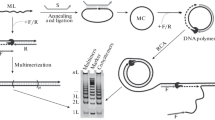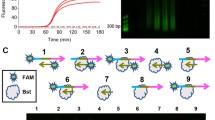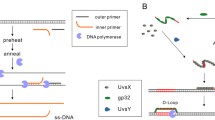Abstract
Methods for isothermal amplification of nucleic acids are gained more attention in the last two decades. For isothermal amplification, DNA polymerases with strand displacement activity are required, and Bst exo− is one of the most commonly used polymerases. However, Bst exo− is able to cause nonspecific DNA amplification through multimerization, which leads to a set of undesirable by-products. In this study, circumstances that facilitate DNA multimerization by Bst exo− polymerase have been determined. We found that an essential requirement for multimerization is the presence of short (50–60 bp) DNA duplexes formed through primer extension after annealing on the template or in homo- and heterodimers. The highest multimerization efficiency is observed for Bst 2.0 polymerase in buffers with a high salt concentration and/or in the presence of reducing agents (for example, β-mercaptoethanol). Multimerization occurs mainly at 55–60 °С, while specific isothermal amplification is more efficient at 60–65 °С. The SYBR Green I intercalating dye inhibits multimerization with Bst LF and Bst 2.0 polymerases in concentrations above 0.25×, whereas inhibition with Bst 3.0 polymerase occurs only above 1.25×. The obtained results allow to elaborate accurate and reliable methods for isothermal amplification of nucleic acids.






Similar content being viewed by others
References
Mullis, K. B., & Faloona, F. A. (1987). Specific synthesis of DNA in vitro via a polymerase-catalyzed chain reaction. Methods in Enzymology, 155, 335–350.
Bartlett, J. M. S., & Stirling, D. (2003). Methods in molecular biology, vol. 226: PCR protocols (2nd ed.). Totowa: Humana.
Demidov, V. V., & Broude, N. E. (2004). DNA amplification: current technologies and applications (1st ed.). Wymondham: Horizon bioscience.
Fakruddin, M., Mannan, K. S., Chowdhury, A., Mazumdar, R. M., Hossain, M. N., Islam, S., & Chowdhury, M. A. (2013). Nucleic acid amplification: alternative methods of polymerase chain reaction. Journal of Pharmacy and Bioallied Sciences, 5(4), 245–252.
Zhao, Y., Chen, F., Li, Q., Wang, L., & Fan, C. (2015). Isothermal amplification of nucleic acids. Chemical reviews, 115(22), 12491–12545.
Fozooni, T., Ravan, H., & Sasan, H. (2017). Signal amplification technologies for the detection of nucleic acids: from cell-free analysis to live-cell imaging. Applied Biochemistry and Biotechnology, 183(4), 1224–1253.
Ko, J., & Yoo, J. C. (2018). Loop-mediated isothermal amplification using a lab-on-a-disc device with thin-film phase change material. Applied Biochemistry and Biotechnology, 186(1), 54–65.
Chen, Y., Cheng, N., Xu, Y., Huang, K., Luo, Y., & Xu, W. (2016). Point-of-care and visual detection of P. aeruginosa and its toxin genes by multiple LAMP and lateral flow nucleic acid biosensor. Biosensors and Bioelectronics, 81, 317–323.
Moghimi, H., Moradi, A., Hamedi, J., & Basiri, M. (2015). Development of a loop-mediated isothermal amplification assay for rapid and specific identification of ACT producing Alternaria alternata, the agent of brown spot disease in tangerine. Applied Biochemistry and Biotechnology, 178(6), 1207–1219.
Kaocharoen, S., Wang, W., Tsui, K. M., Trilles, L., Kong, F., & Meyer, W. (2008). Hyperbranched rolling circle amplification as a rapid and sensitive method for species identification within the Cryptococcus species complex. Electrophoresis, 29(15), 3183–3191.
Wang, X. R., Wu, L. F., Wang, Y., Ma, Y. Y., Chen, F. H., & Ou, H. L. (2015). Rapid detection of Staphylococcus aureus by loop-mediated isothermal amplification. Applied Biochemistry and Biotechnology, 175(2), 882–891.
Liu, W., Zhang, H., Hu, D., Lu, S., & Sun, X. (2018). The performance of MALBAC and MDA methods in the identification of concurrent mutations and aneuploidy screening to diagnose beta-thalassaemia disorders at the single- and multiple-cell levels. Journal of Clinical Laboratory Analysis, 32(2), e22267.
Tao, C., Yang, Y., Li, X., Zheng, X., Ren, H., Li, K., & Zhou, R. (2016). Rapid and sensitive detection of sFAT-1 transgenic pigs by visual loop-mediated isothermal amplification. Applied Biochemistry and Biotechnology, 179(6), 938–946.
Lv, J., Xie, S., Cai, W., Zhang, J., Tang, D., & Tang, Y. (2017). Highly effective target converting strategy for ultrasensitive electrochemical assay of Hg2+. The Analyst, 142(24), 4708–4714.
Notomi, T., Okayama, H., Masubuchi, H., Yonekawa, T., Watanabe, K., Amino, N., & Hase, T. (2000). Loop-mediated isothermal amplification of DNA. Nucleic Acids Research, 28(12), E63.
Compton, J. (1991). Nucleic acid sequence-based amplification. Nature, 350(6313), 91–92.
Walter, N. G., & Strunk, G. (1994). Strand displacement amplification as an in vitro model for rolling-circle replication: deletion formation and evolution during serial transfer. Proceedings of the National Academy of Sciences of the United States of America, 91(17), 7937–7941.
Fire, A., & Xu, S. Q. (1995). Rolling replication of short DNA circles. Proceedings of the National Academy of Sciences of the United States of America, 92(10), 4641–4645.
Mohsen, M. G., & Kool, E. T. (2016). The discovery of rolling circle amplification and rolling circle transcription. Accounts of Chemical Research, 49(11), 2540–2550.
Ali, M. M., Li, F., Zhang, Z., Zhang, K., Kang, D. K., Ankrum, J. A., Le, X. C., & Zhao, W. (2014). Rolling circle amplification: a versatile tool for chemical biology, materials science and medicine. Chemical Society Reviews, 43(10), 3324–3341.
Murakami, T., Sumaoka, J., & Komiyama, M. (2009). Sensitive isothermal detection of nucleic-acid sequence by primer generation-rolling circle amplification. Nucleic Acids Research, 37(3), e19.
Gu, L., Yan, W., Liu, L., Wang, S., Zhang, X., & Lyu, M. (2018). Research progress on rolling circle amplification (RCA)-based biomedical sensing. Pharmaceuticals, 11(2), 35.
Oscorbin, I. P., Boyarskikh, U. A., & Filipenko, M. L. (2015). Large fragment of DNA polymerase I from Geobacillus sp. 777: cloning and comparison with DNA polymerases I in practical applications. Molecular Biotechnology, 57(10), 947–959.
Oscorbin, I. P., Belousova, E. A., Boyarskikh, U. A., Zakabunin, A. I., Khrapov, E. A., & Filipenko, M. L. (2017). Derivatives of Bst-like Gss-polymerase with improved processivity and inhibitor tolerance. Nucleic Acids Research, 45(16), 9595–9610.
Zyrina, N. V., Antipova, V. N., & Zheleznaya, L. A. (2014). Ab initio synthesis by DNA polymerases. FEMS Microbiology Letters, 351(1), 1–6.
Hafner, G. J., Yang, I. C., Wolter, L. C., Stafford, M. R., & Giffard, P. M. (2001). Isothermal amplification and multimerization of DNA by Bst DNA polymerase. BioTechniques, 30(4), 852–867.
Wang, G., Ding, X., Hu, J., Wu, W., Sun, J., & Mu, Y. (2017). Unusual isothermal multimerization and amplification by the strand-displacing DNA polymerases with reverse transcription activities. Scientific Reports, 7(1), 13928.
Viguera, E., Canceill, D., & Ehrlich, S. D. (2001). In vitro replication slippage by DNA polymerases from thermophilic organisms. Journal of Molecular Biology, 312(2), 323–333.
Qian, J., Ferguson, T. M., Shinde, D. N., Ramírez-Borrero, A. J., Hintze, A., Adami, C., & Niemz, A. (2012). Sequence dependence of isothermal DNA amplification via EXPAR. Nucleic Acids Research, 40(11), e87.
Sambrook, J., & Russell, D. W. (2006). Isolation of DNA fragments from polyacrylamide gels by the crush and soak method. CSH Protocols., 2006(1), pdb.prot2936. https://doi.org/10.1101/pdb.prot2936.
Güixens-Gallardo, P., Hocek, M., & Perlíková, P. (2016). Inhibition of non-templated nucleotide addition by DNA polymerases in primer extension using twisted intercalating nucleic acid modified templates. Bioorganic & Medicinal Chemistry Letters, 26(2), 288–291.
Lee, D., Shin, Y., Seok, C., Hwang, K. S., Yoon, D. S., & Lee, J. H. (2016). Simple and Highly sensitive molecular diagnosis of Zika Virus by lateral flow analysis. Analytical Chemistry, 88(24), 12272–12278.
Oscorbin, I. P., Belousova, E. A., Zakabunin, A. I., Boyarskikh, U. A., & Filipenko, M. L. (2016). Comparison of fluorescent intercalating dyes for quantitative loop-mediated isothermal amplification (qLAMP). Biotechniques., 61, 20–25.
Funding
This work was supported by the Russian State Federal budget (No. АААА-А16-116020350032-1).
Author information
Authors and Affiliations
Corresponding author
Ethics declarations
Conflict of interest
The authors declare that they have no conflict of interest.
Additional information
Publisher’s Note
Springer Nature remains neutral with regard to jurisdictional claims in published maps and institutional affiliations.
Rights and permissions
About this article
Cite this article
Garafutdinov, R.R., Gilvanov, A.R. & Sakhabutdinova, A.R. The Influence of Reaction Conditions on DNA Multimerization During Isothermal Amplification with Bst exo− DNA Polymerase. Appl Biochem Biotechnol 190, 758–771 (2020). https://doi.org/10.1007/s12010-019-03127-6
Received:
Accepted:
Published:
Issue Date:
DOI: https://doi.org/10.1007/s12010-019-03127-6




